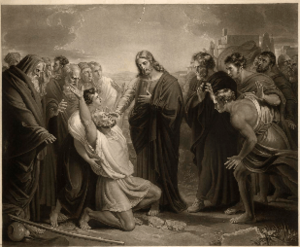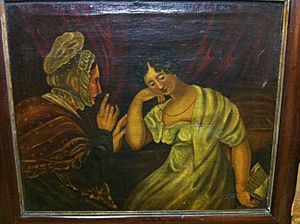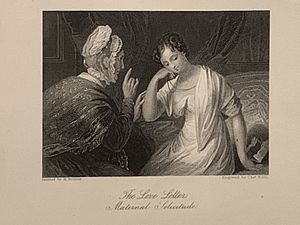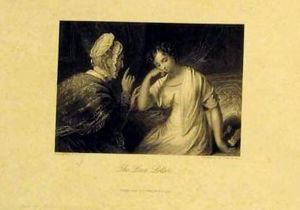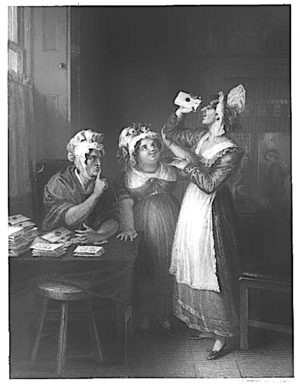Henry James Richter facts for kids
Quick facts for kids
Henry James Richter
|
|
|---|---|
| Born | 8 March 1772 |
| Died | 8 April 1857 (aged 85) Lisson Grove, London
|
| Nationality | German |
| Education | St. Martins Library School London, Royal Academy of Art |
|
Notable work
|
The Tight Shoe, Brute of a Husband, Christ Giving Sight to the Blind, The Love Letter, Casting Off the Widow's Weeds |
| Patron(s) | William Chamberlayne (MP) |
Henry James Richter (1772–1857) was a talented artist and thinker. He was born in London on March 8, 1772. Richter became a member of the Royal Academy, a famous art institution. He was known for his paintings and his ideas about philosophy.
Contents
Richter's Family and Early Life
Henry James Richter was the second of five children born to John Augustus Richter and Mary Haig. His father, John Augustus Richter, was an artist from Dresden, Germany. He was skilled at making surfaces look like real marble. John Augustus Richter also created a popular children's toy called Richter's Anchor Blocks. An example of these blocks is now in the UK National Trust Museum of Childhood.
Henry's older brother, John Richter (1769?–1830), was involved in politics. He was a member of the London Corresponding Society, a group that wanted to change how Britain was governed. John was once arrested for trying to overthrow the government, but he was later released.
In 1794, Henry and his brother John worked together on a special project. They created a book of poems called Paradise Lost by John Milton. Henry drew 13 pictures for the book. They gave a copy of this book to Prince George, who later became King.
Henry Richter went to school at Dr. Barrow's Academy in Soho Square, London. He likely attended this school between the ages of 13 and 18. The school taught subjects like math, French, drawing, and even dancing.
Becoming an Artist
Around 1787, Henry Richter began learning from the artist Thomas Stothard. They became close friends. Richter also started working with another famous artist, William Blake.
In 1788, Richter created his first drawings for William Shakespeare's plays. He also showed his first paintings at the Royal Academy. He continued to exhibit his art there for many years. In 1790, he became a student at the Royal Academy Schools, where he studied things like anatomy.
Richter's Illustrations
During the 1790s, Richter mostly worked as an illustrator. He was good at both drawing and engraving pictures for books. Some of his projects included illustrations for famous books like Sir Charles Grandison and Clarissa Harlowe by Samuel Richardson. He also illustrated Lives of the English Poets by Samuel Johnson and Paul and Virginia by J.-H. Bernardin de Saint-Pierre.
Richter lived on Newman Street in London, which was known as "Artists Street." Many famous artists lived there, including Benjamin West and Thomas Stothard.
Art Career and New Ideas
In 1809, Richter started showing his art at the Associated Artists in Water Colours. He became a member in 1810 and was even president in 1811–12. One of his most popular paintings from this time was A Brute of a Husband. He also painted scenes from literature, like characters from Don Quixote. He was one of the few artists who painted historical scenes using watercolors.
In 1812, Richter painted an oil painting called Christ Giving Sight to the Blind. He painted it outdoors on the roof of his house to capture the bright sunlight.
This painting was bought by the British Institution for a lot of money and later placed in a church in Greenwich. Richter even painted a second version to try and make it even more realistic.
Richter's Philosophy and Writings
In 1817, Richter published a pamphlet called Daylight: a recent discovery in the art of painting. In this writing, he shared his ideas about art and philosophy. He was interested in the ideas of the philosopher Immanuel Kant. Richter believed in painting from nature and even used clay or wax models for his compositions. His ideas influenced other artists.
Richter also wrote other philosophical works. He wrote an article called Metaphysics for the Encyclopaedia Londonensis. He also wrote a paper in 1855 called German Transcendentalism.
Later Career and Engravings
Richter continued to be a member and frequent exhibitor at the Society of Painters in Water Colours. Between 1827 and 1828, a young artist named John Sartain learned from Richter. Sartain became a skilled engraver. Richter asked Sartain to engrave his painting The Tight Shoe. Sartain later became a very famous engraver in the United States.
Richter's paintings became very popular through engravings, which allowed many people to see his work. He also created illustrations for popular yearly books like the Forget-me-Not. His painting The School in an Uproar was so popular that it was even printed on pocket handkerchiefs! He created around 150 works, including drawings, engravings, and paintings. Some of his art can be seen in the British Museum.
One of his famous paintings is The Love Letter.
This painting shows characters from Sir Walter Scott's book The Antiquary. A poem about the painting was written by Letitia Elizabeth Landon. The painting shows Mrs. Mailsetter giving advice to Jenny Caxon, who has received a love letter. An engraving of this painting was published in 1833.
Another engraving based on Richter's work was titled One Peep Was Enough.
Personal Life and Legacy
Henry James Richter was married twice. First, to Elizabeth Smith in 1808, and then to Charlotte Sophia Edson in 1818. He had at least two sons and two daughters.
Henry James Richter passed away on April 8, 1857, at his home in London, at the age of 85. At the time of his death, he was working on translating a philosophical book.
His daughter, Henrietta Sophia Richter (1813–1896), was also a talented artist. She was a portrait painter and showed her work at the Royal Academy. His son, Henry Constantine Richter (1821–1902), became a well-known artist who drew and made prints of birds and mammals. His illustrations were used in the books of the famous bird artist John Gould.
Images for kids


